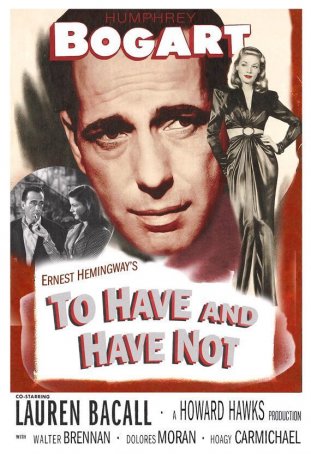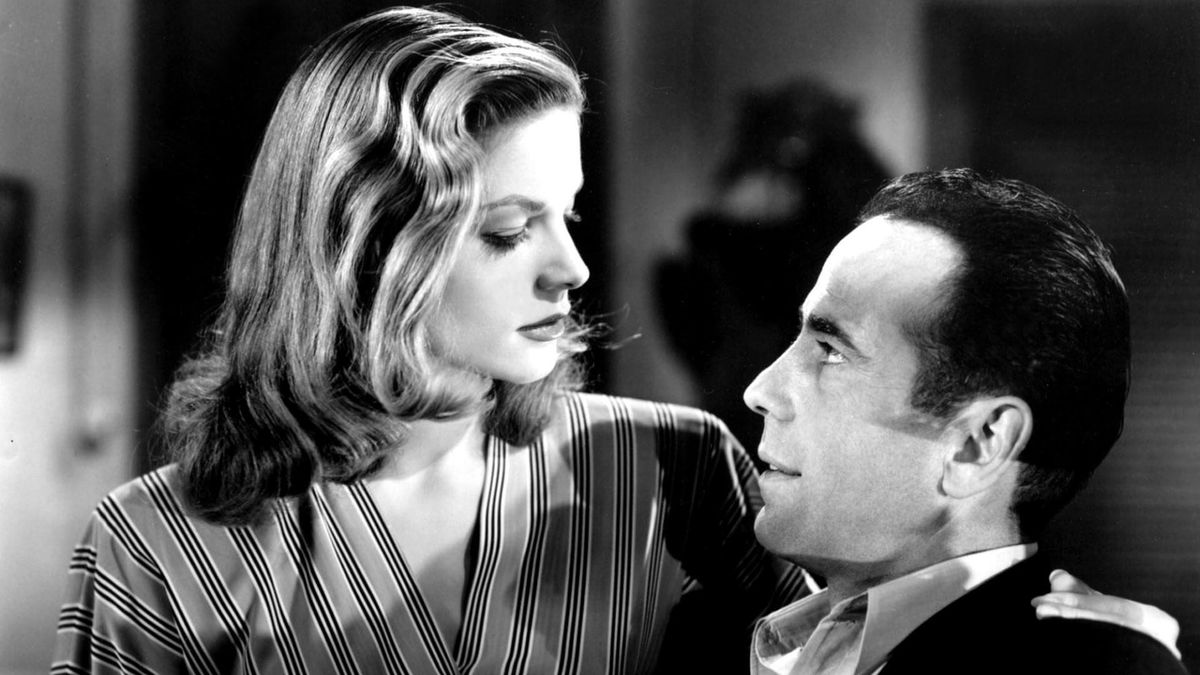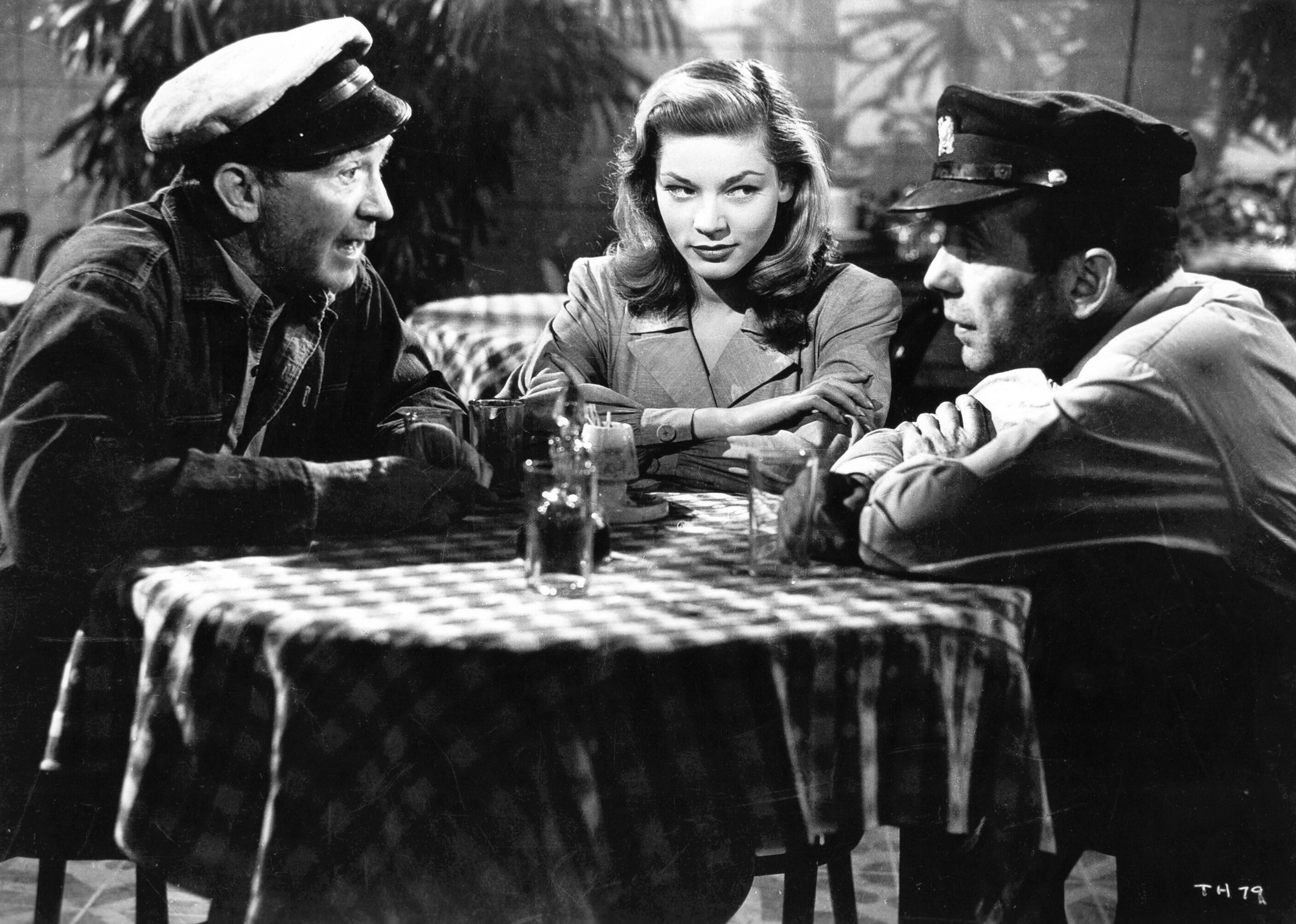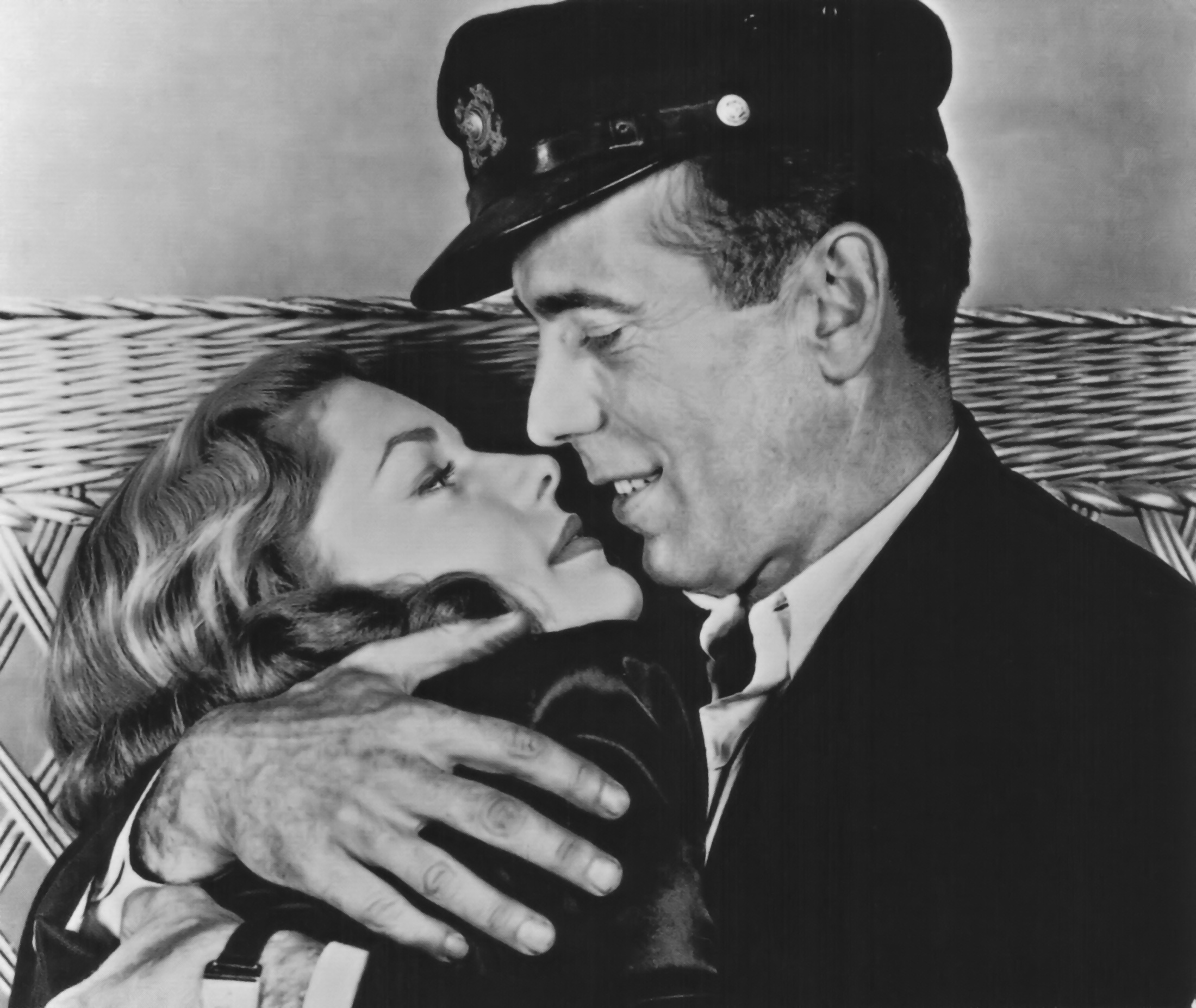To Have and Have Not (United States, 1944)

Despite boasting an impressive roster of talent both in front of and behind the camera, To Have and Have Not remains a "lesser" film on Humphrey Bogart's resume, often euphemistically referred to as a "minor" or "overlooked" classic. Labeling it as such is charitable – the movie is entertaining in its own right, and representative of the era in which it was produced but, aside from the legendary interaction between Bogart and Lauren Bacall, there are only moderate reasons to recommend the film, which often comes across as little more than a low-rent attempt to regurgitate elements that allowed Casablanca to succeed two years earlier.
For director Howard Hawks, this represented his first opportunity to work with Bogart (they would re-team shortly thereafter for The Big Sleep). The decision to use an unknown model to play the taciturn leading man's love interest was Hawks' idea. The producer/director, who fancied himself as a star maker, decided that Lauren Bacall had the looks and presence to make a name for herself. However, to Hawks' dismay, Bogart took a liking to her, and she to him (likely stymieing designs he may have had on her – instead, he contented himself with having an affair with the movie's other actress, Dolores Moran). The rest, as they say, is history. No love affair in the history of Hollywood has been as romanticized or publicly followed (not even Spencer Tracy and Katharine Hepburn).
In title and intent, To Have and Have Not is a loose (emphasis on the word "loose") adaptation of the 1937 Ernest Hemingway novel, but the plot, as re-worked by Jules Furthman and William Faulkner, bears a stronger resemblance to Casablanca than to anything penned by the Pulitzer-prize winning author. Many of the elements are similar: the World War II time frame, an exotic setting (Martinique instead of Cuba, where the book was set), a mercenary lead character whose political neutrality changes as the story develops, anti-German/Vichy freedom fighters, and a bar with a piano player. Ultimately, however, To Have and Have Not's narrative is not as compelling as that of Casablanca, the dialogue is (for the most part) neither as sharp nor memorable, the tone is more flippant, and the romance does not require an ennobling sacrifice.
 According to
legend, Hawks bet Hemingway that he could make a movie out of the author's
worst book. When Hemingway inquired what that was, Hawks responded, "To
Have and Have Not." Once permission was granted, Hawks enlisted the
aid of Furthman, who wrote a reasonably faithful adaptation, then Faulkner (who
had not yet earned his own Pulitzer) to re-shape things in a way that would be
more cinematically appealing. Although Hemingway's name appears prominently on
the title screen ("Ernest Hemingway's To Have and Have Not"),
a magnifying glass is needed to find the crumbs of the novel that remain.
According to
legend, Hawks bet Hemingway that he could make a movie out of the author's
worst book. When Hemingway inquired what that was, Hawks responded, "To
Have and Have Not." Once permission was granted, Hawks enlisted the
aid of Furthman, who wrote a reasonably faithful adaptation, then Faulkner (who
had not yet earned his own Pulitzer) to re-shape things in a way that would be
more cinematically appealing. Although Hemingway's name appears prominently on
the title screen ("Ernest Hemingway's To Have and Have Not"),
a magnifying glass is needed to find the crumbs of the novel that remain.
To Have and Have Not opens in Martinique shortly after the fall of Paris to the Nazis. Harry Morgan (Bogart), an American expatriate, has landed in the city of Fort de France, where he is making a living taking visitors out on his boat, the Queen Conch, for fishing expeditions. Harry is accompanied on these trips by his faithful drunkard sidekick, Eddie (Walter Brennan). New to Fort de France is 22-year old Marie Browning (Bacall), whose trail of tears has left her on the island without enough money to buy a ticket home. She tries lifting the wallet of one of Harry's wealthy clients, but Harry catches her – only to learn the client was planning to stiff him.
The plot that forms the background for Harry and Marie's relationship is a thin story about two French resistance fighters, Paul de Bursac (Walter Molnar) and his wife, Hellene (Moran), who end up in Harry's care when he accepts a job to transport them to Fort de France without discovery. When Paul is wounded, Harry is forced to endanger his own safety and security to provide medical care. Meanwhile, Marie hangs around to help and provide plenty of sexual chemistry. And, when the local Gestapo-like officer, Captain Renard (Dan Seymour), offers Harry a handsome reward for turning over the de Bursacs, he must choose between money and principals.
 The aspect that
elevates To Have and Have Not, and the best reason to watch this movie,
is the interaction between Bogart and Bacall. Not only is this the first movie
they made together, but it is, in a sense, a cinematic record of their falling
in love. Bogey and his favorite leading lady made four films together (after
this one, The Big Sleep, Dark Passage, and Key Largo), and the
sparks between them represent the unquestionable centerpiece of each one. The
chemistry is at its strongest and most unmistakable in To Have and Have Not.
There are times when Bacall's performance shows the rawness of her
inexperience, but those moments are easily overlooked when we note how strongly
matched she and Bogart are. Her screen presence reduces her limited acting
experience to an irrelevance.
The aspect that
elevates To Have and Have Not, and the best reason to watch this movie,
is the interaction between Bogart and Bacall. Not only is this the first movie
they made together, but it is, in a sense, a cinematic record of their falling
in love. Bogey and his favorite leading lady made four films together (after
this one, The Big Sleep, Dark Passage, and Key Largo), and the
sparks between them represent the unquestionable centerpiece of each one. The
chemistry is at its strongest and most unmistakable in To Have and Have Not.
There are times when Bacall's performance shows the rawness of her
inexperience, but those moments are easily overlooked when we note how strongly
matched she and Bogart are. Her screen presence reduces her limited acting
experience to an irrelevance.
Harry and Marie never call each other by their proper names. Instead, they are "Slim" and "Steve" - the endearments by which Hawks and his wife addressed each other in real life. Early drafts of the script envisioned a smaller part for Bacall but, once it became apparent that she and Bogart were burning up the screen, Hawks re-wrote page after page to bolster her part at the expense of Moran's. Hellene de Bursac, originally developed as a secondary love interest for Harry, was reduced to filling a limp supporting role that had her standing by her man and questioning why she was doing so.
The dialogue, which takes full advantage of the burgeoning romance between the leads, sparkles during some of their exchanges. The most memorable lines are spoken by Bacall, employing double entendres so obvious it's amazing they slid past the censors: "You don't have to act with me, Steve. You don't have to say anything and you don't have to do anything. Not a thing. Oh, maybe just whistle. You know how to whistle, don't you, Steve? You just put your lips together and… blow." As good as the words are, though, it takes Bacall's delivery to do them justice. The temperature in Harry's room goes up by about ten degrees.
 Even though
Bacall and Bogart demand the camera's full attention any time they're on
screen, a couple of supporting performers deserve mention. As the piano player
Cricket, songwriter Hoagy Carmichael is given more than a token opportunity to
tinkle the ivories and sing along (accompanied on a couple of occasions by
Bacall). Veteran character actor and three-time Oscar winner Walter Brennan,
playing "older" as he did so often, is Eddie, a good-hearted drunk
who might easily get on the hero's (and audience's) nerves if he wasn't so
harmless.
Even though
Bacall and Bogart demand the camera's full attention any time they're on
screen, a couple of supporting performers deserve mention. As the piano player
Cricket, songwriter Hoagy Carmichael is given more than a token opportunity to
tinkle the ivories and sing along (accompanied on a couple of occasions by
Bacall). Veteran character actor and three-time Oscar winner Walter Brennan,
playing "older" as he did so often, is Eddie, a good-hearted drunk
who might easily get on the hero's (and audience's) nerves if he wasn't so
harmless.
Taking note of what worked best in To Have and Have Not, Hawks decided to emphasize that same element in his next movie, The Big Sleep. Fans of that delicious film noir have often noted that the plot frequently doesn't make sense, but the interaction between Bogart and Bacall is compelling enough to keep even the most inattentive viewer from losing interest. The pair married shortly after the completion of principal photography on The Big Sleep. By the time Hawks brought them back for a series of re-shoots (primarily to boost the size of Bacall's role), the wedding was in the rearview mirror. Bacall was Bogart's fourth wife and she remained married to him until his 1957 death.
As is often true of older movies, expectations have a lot to do with how To Have and Have Not is received. Those anticipating something along the lines of Casablanca will be disappointed. Despite the superficial similarities and Warner Brothers' obvious desire to point them out, To Have and Have Not is inferior in almost every way that matters. But for those who visit this movie to vicariously experience the beginnings of Hollywood's most famous romance, it delivers in full. Anyone who lets the film's less-than-convincing storyline fade into the background and concentrates instead on the sexually-charged dance between Harry and Marie will accept that To Have and Have Not has all it needs.
To Have and Have Not (United States, 1944)
Cast: Walter Brennan, Lauren Bacall, Dolores Moran, Hoagy Carmichael, Walter Molnar, Marcel Dalio, Walter Sande, Humphrey Bogart, Dan Seymour
Screenplay: Jules Furthman and William Faulkner, based on the novel by Ernest Hemingway
Cinematography: Sid Hickox
Music: William Lava, Franz Waxman
U.S. Distributor: Warner Brothers
U.S. Release Date: -
MPAA Rating: "NR" (Violence, Sexual Content)
Genre: Thriller
Subtitles: none
Theatrical Aspect Ratio: 1.33:1
- Rio Bravo (1959)
- (There are no more better movies of Walter Brennan)
- (There are no more worst movies of Walter Brennan)
- Manderlay (1969)
- Ready to Wear (1994)
- (There are no more worst movies of Lauren Bacall)
- (There are no more better movies of Dolores Moran)
- (There are no more worst movies of Dolores Moran)
Comments